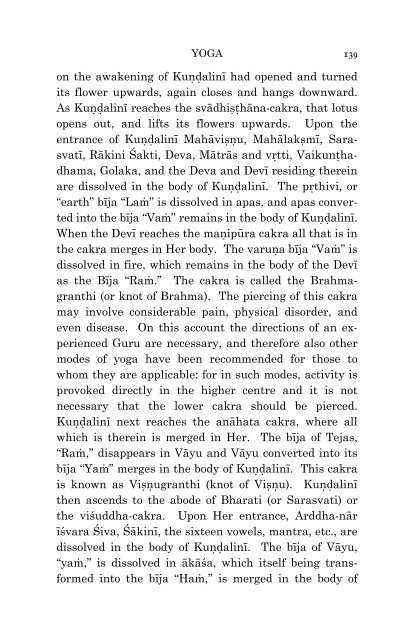Introduction to Tantra Sastra - Aghori
Introduction to Tantra Sastra - Aghori
Introduction to Tantra Sastra - Aghori
You also want an ePaper? Increase the reach of your titles
YUMPU automatically turns print PDFs into web optimized ePapers that Google loves.
YOGA 139<br />
on the awakening of Kuṇ ḍ alinī had opened and turned<br />
its flower upwards, again closes and hangs downward.<br />
As Kuṇ ḍ alinī reaches the svādhiṣṭ hāna-cakra, that lotus<br />
opens out, and lifts its flowers upwards. Upon the<br />
entrance of Kuṇ ḍ alinī Mahāviṣṇ u, Mahālakṣmī, Sarasvatī,<br />
Rākini Śakti, Deva, Mātrās and vṛ tti, Vaikunṭ hadhama,<br />
Golaka, and the Deva and Devī residing therein<br />
are dissolved in the body of Kuṇ ḍ alinī. The pṛ thivi, or<br />
“earth” bīja “Laṃ” is dissolved in apas, and apas converted<br />
in<strong>to</strong> the bīja “Vaṃ” remains in the body of Kuṇ ḍ alinī.<br />
When the Devī reaches the maṇ ipūra cakra all that is in<br />
the cakra merges in Her body. The varuṇ a bīja “Vaṃ” is<br />
dissolved in fire, which remains in the body of the Devī<br />
as the Bīja “Raṃ.” The cakra is called the Brahmagranthi<br />
(or knot of Brahma). The piercing of this cakra<br />
may involve considerable pain, physical disorder, and<br />
even disease. On this account the directions of an experienced<br />
Guru are necessary, and therefore also other<br />
modes of yoga have been recommended for those <strong>to</strong><br />
whom they are applicable: for in such modes, activity is<br />
provoked directly in the higher centre and it is not<br />
necessary that the lower cakra should be pierced.<br />
Kuṇ ḍ alinī next reaches the anāhata cakra, where all<br />
which is therein is merged in Her. The bīja of Tejas,<br />
“Raṃ,” disappears in Vāyu and Vāyu converted in<strong>to</strong> its<br />
bīja “Yaṃ” merges in the body of Kuṇ ḍ alinī. This cakra<br />
is known as Viṣṇ ugranthi (knot of Viṣṇ u). Kuṇ ḍ alinī<br />
then ascends <strong>to</strong> the abode of Bharati (or Sarasvati) or<br />
the viśuddha-cakra. Upon Her entrance, Arddha-nār<br />
īśvara Śiva, Śākinī, the sixteen vowels, mantra, etc., are<br />
dissolved in the body of Kuṇ ḍ alinī. The bīja of Vāyu,<br />
“yaṃ,” is dissolved in ākāśa, which itself being transformed<br />
in<strong>to</strong> the bīja “Haṃ,” is merged in the body of

















